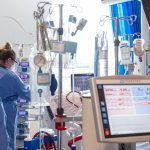The UK is testing how hydrogen can be piped into people’s homes through the existing gas network at a world-leading research site visited by Sky News.
But engineers say the role of hydrogen in efforts to reduce emissions and tackle climate change is still unclear and depends on whether the government commits to the production of so-called “green zero-carbon hydrogen”.
The UK’s first hydrogen testing site is in a remote part of Cumbria, not far from the England-Scotland border, hidden within an RAF base.
Several kilometres of pipes are being laid – some new and some transported here from the existing gas network.
Nearby is a row of terraced houses fitted with a hydrogen boiler. Inside the houses the furniture includes a table laid up as if set for people to sit down and eat.
Except nobody lives here.
They are set up to show how a normal home can have hydrogen piped in in the same way as gas. The message is simply – the consumer won’t know the difference.
This test site is being run to prove how the existing gas network can be repurposed and the use of hydrogen scaled up. They have a window of time to gather the evidence.
Tim Harwood, from Northern Gas Networks, said: “We believe we can make hydrogen safer than it is with natural gas at the moment.
“There are 23 million homes in the UK which have gas supply. We can repurpose the billions of pounds of infrastructure that we’ve got. It could be absolutely massive.
“Thirty percent of all the carbon emissions in the UK come from heating in the homes, so we’ve got a great prize to go at.”
But there are big hurdles to overcome. Hydrogen is not yet a climate solution.
This test site uses what’s called grey hydrogen, which still has a carbon footprint.
The UK doesn’t have zero-carbon hydrogen at scale, and it would require significant commitment and investment.
Hari Vamadevan, from DNV – which runs the site, said: “Hydrogen being transported and delivered through the existing network will be achievable. The challenge will be whether there is sufficient hydrogen to go into the network.”
Antony Green, project director for Hydrogen Transportation and Gas at the National Grid, has high hopes for hydrogen.
He told Sky News: “The potential is there. This period we are in is very much a proof period and that will ultimately drive how big it can become.
“How much it will feature in our green future is still to be established.
“Hydrogen and electrification sit hand in hand. Where that balance point sits remains to be seen. You’ve got the efficiency of one and the storage capacity of the other, that’s where almost the sweet spot starts to sit.”
Hydrogen has different physical properties from natural gas and the project tests how the current transmission network will perform with hydrogen at various blends.
Methane has been used to heat our homes and for power stations to generate electricity for years – currently around 85% of homes and around 40% of the UK’s electricity relies on gas.
But the Committee on Climate Change, which advises the government how to get to net zero, says hydrogen is not a “silver bullet solution”.
It says significant volumes of low-carbon hydrogen should be produced with carbon capture storage by 2030 to help the industry grow.
The plan is for hydrogen to go into the first homes in the UK by 2023, increasing to a hydrogen village by 2025, then a hydrogen town by 2030.
This site in Cumbria, which uses grey hydrogen, now has a window to secure the evidence that hydrogen – whilst not a silver bullet – has a key role to play in the road to net zero.
Grey hydrogen is not low carbon because the carbon is not captured.
Green hydrogen is produced from electrolysis of water. It uses electricity which has to be renewable electricity to be truly green and that gives 100% hydrogen purity.
Sky News broadcasts the first daily prime time news show dedicated to climate change.
Hosted by Anna Jones, The Daily Climate Show is following Sky News correspondents as they investigate how global warming is changing our landscape and how we all live our lives.
The show will also highlight solutions to the crisis and show how small changes can make a big difference.






















